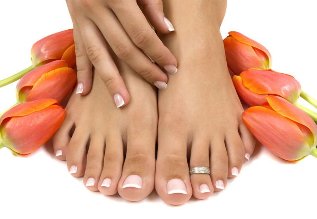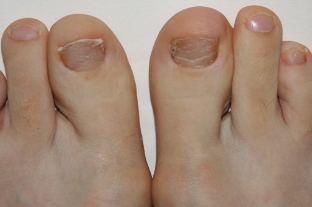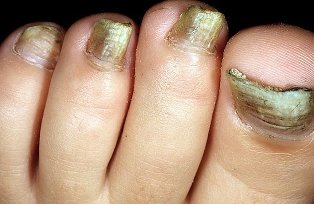Many are not aware of the banal and the perspiration of the feet is accompanied by the unpleasant smell that is more than half of the population of the planet, this is one of the main symptoms of nail fungus. In this affliction, you run the risk of getting sick of all of it, although it's a bit overlooked is the importance of personal hygiene. Nail fungus lurking in all sorts of places, especially in the areas of public service. And the most frightening is the fact that nail fungus is a very insidious disease, and the treatment is of long duration, and it is not always successful, as well as the athlete's foot tends to be repeat offenders. In order to recognize the disease and begin treatment, you need to know all of the signs of the fungus on the feet.

How is the spread of the disease?
The infection will cause a parasitic fungus. The ideal environment for their breeding and development — an increase in moisture, combined with a warm atmosphere. It is considered that the main areas where it is a high risk of being infected with a fungal infection of the nail it is the baths, saunas, aqua parks, swimming pools, and salons for a manicure, and a t. d. However, the statistics are in completely refuting this statement: the fungus, the nail can be the wedding of the house, through the ordinary stuff (towels, shoes, clothes, carpet, shower, or toilet), and if someone in the family who has already have this problem, or is a party, for example, through the dressing room, kindly offered to master's degree, and it may not even be suspicious of the presence of this disease.
But what are the factors that influence the development of the disease fungal diseases? Point out key moments that have led to the infection in onychomycosis:
- the fall of the immunity;
- trauma to the nail plate;
- poor circulation in the lower limbs, which may occur when it is used close to the shoes;
- the pathology of the stop, the nature of wood;
- with the obesity.
- diabetes mellitus;
- the increase in the body.
At least in part, to protect itself, it should be used only and exclusively for your own stuff, be careful in dealing with an anti-septic bath and shower facilities, use of personal towels, regularly clean and wash the carpets, abyssariatü shoes. And so as not to miss the window of opportunity for treatment of ringworm time to time (because everyone knows that the therapy is most effective in the early stages of the development of the disease, you will need to know the early signs of nail fungus in the feet.
How to recognize onychomycosis?
The signs of toenail fungus and the different steps can be different from each other, what does it say about the progression of the infection. For example, in the first (or previous) stage, no symptoms are practically non-existent. On the nails, and a board, you can see a barely noticeable white specks or streaks. These symptoms should alert you, as long as they can talk to you about the presence of a fungal infection. If you ignore the early warning signs of the disease, there is the risk of a fungus, which leads to the nails to be healthy and to take in the future, and the appearance of pus in the Okolonatof evye of the fabric, and it does run the risk of gangrene and amputation of the lower limbs.
In the second grade of the disease, fungal diseases of the nails, manifested a lack of shine to the natural nail plate. The more the nail changes color, which appear yellowing, white, brown, and stripes. You can warp to the top of the nail, and the side portions thereof. These symptoms may also be seen in the picture.
Starting with the phase of the onichamicose characterized Lomastüю e-beam nail plate, inflammation of the cuticle. There is a risk of the loss of the nail. But the most unpleasant is that the disease continues to spread to other nails of the lower limbs, and also on the skin to stop it. The treatment in this case, you must begin immediately in order to avoid the unpleasant consequences of the disease.

In the second, and the third phase of the onichamicose the patient can recognize that you are the nail that gets a tint of yellow or a dirty brown color, it becomes gooey and thick, it fell far short of the nail bed, it becomes very fragile and brittle. Sometimes wearing a shoe that is closed, it becomes a painful and itchy on the skin and unbearable (this problem is particularly enhanced when the sweating is excessive). In addition to this, all cause for suspicion of onychomycosis can follow that are related to the symptoms manifested on the skin, close to the situated in the nails:
- a burning sensation;
- I am intolerant to itch;
- the flaking and dryness;
- the inflammation;
- crying out the outbreaks;
- thickness, and actinic.
By recognizing the early signs of nail fungus, you should immediately consult with a specialist who will prescribe the optimal treatment plan.
How are the different types of onichamicose?
Choose 3 kinds of onichamicose, each of which manifests its own characteristics.
- Normteroticheski nail fungus is characterized by a change in the color of the nail plate: the patient is in the nail it can have tones that range from white to dark green. In the first stage of the disease, the nail will appear round and the white patches or simply. With the progression of the disease, the tone of the nail can be changed, and that the fungus is spread in the entire area of the nail plate. However, the thickness doesn't change, then yes, the brightness is maintained.
- Depending on the fungus in the nails is manifested in the change of the color of the nail plate, the loss of gloss of the surface, the strong thickening and deformation. The nails are strongly layertXia, begins with the destruction of the part.
- Accretive is a fungus that is characterized by a change in the color of the nail, with its IPtoceniam. The effect of this fungal defeat is a rejection of the patient's nails, or on a stage.
To identify the presence of the fungus in the nail it may, however, establish a precise diagnosis can only be a specialist. For this reason, you need to go to a clinic, go on to the examination of a scraping from a patient with the nail or the skin that is located around it. In addition, the doctor attaches a microscopic examination.
The signs of mold in postdandtELU disease
The success of the treatment of toenail fungus depends on how well it is diagnosed, the causal agent of the disease. This can be explained by the fact that the disease causes a kind of mold, but there are many, and each and every one of them sensitive to certain drugs. That is, a variation in the fungi that are resistant to one drug, the other is the causal agent of tool and die.

Most of the nail fungus causes:
- for the yeast;
- the dermatophytes;
- template.
If that is the root cause of the fungus from the nail to become the go-to starter, and then to identify the disease immediately, it is next to impossible. Signs of fungus under the nails of the feet, if this is the case, are as follows (they appear after a long period of time): peel nail plate, and mild itching on the skin around the nail (the itching can be absent). Infection nail yeast is found at a 4-4,5% of the time.
Dermatophytes surprised with the nail of a man, more than the previous one, is the causal agent that is 94,5% of all cases of infection of the nails by a fungus. The dermatophytes fall into three types, with the purchase of each and every one of them manifests itself in many different ways:
- For the first type of feature of a comprehensive defeat to a stop, the feet and the nails. The pathogen is spread easily on the skin, and the nails of the hands.
- The second type affects only the nail of the little toe or the big toe of the foot. It can be spread to the interdigital folds, and the fingers of some of them.
- The third type is characteristic of a defeat to the nail of the thumb and little finger, however, the skin and the fungus doesn't affect them.
The last type of yeast — mold). Its causative agent — the molds and mushrooms. Together, this disease is only about 1% of the time. Developing this type of fungus most commonly in people with HIV.
Other symptoms of a fungal infection of the nails
More often than not, the onset of the disease, visible signs of fungal defeat of the nails are missing. However, be aware, you may notice a few changes in the structure of the nail and the appearance of it. As has already been mentioned above, the nail plate may appear a long, or round off the point of the nail it may become a curve, with its softness and brightness, is lost. Progressing, the disease, which further destroys the nail plate are: first, it changes the tone, and then the surface of the nail becomes flaky, it thickens, or becomes very subtle, exfoliated, it breaks. The color of the nail depends on the type of fungal infection that become the causative agent of the infection.
In addition to the main signals of the onichamicose, there are others):

- the fragility of the edges of the nail plate, or the whole of its surface.
- the distortion of the shapes in the nail, a change to the framework.
- darkening of the nail;
- to penetrate the nail and the skin;
- enlarged, somnolence, general weakness;
- the separation of the plates from the nail bed, which leads to the formation of dental plaque from under the nail white or yellow in color, with an unpleasant odor;
- the itching, cracking, burning of the skin, in close proximity to the awe of the nail;
- goiter, dizziness, general weakness.
Any deviation in the appearance of the nails of the foot should be advised, because you may be talking about the development of the fungus in the nail. In the first case, in this case, the road to a dermatologist, who will either confirm or oprovergnett their concerns. If you do not do so promptly, the disease will progress. At first glance, it is nothing wrong with this disease, it is not. However, in addition to the purely aesthetic problems and discomfort, the fungus may cause serious complications, including infection and purulent, the affected areas, and even the development of gangrene. So, do not over-tighten the the treatment, take steps immediately, as the disease was discovered.





























